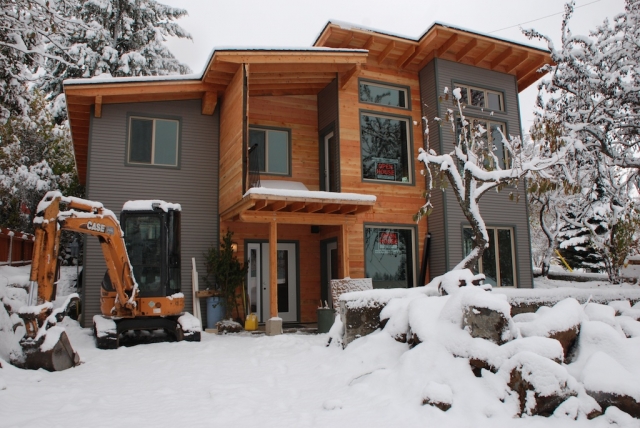COMMENT: Zoning bylaw grew from Rosslanders' voices and holds promise for the future
Bill Micklethwaite recently wrote a letter to the editor, “Zoning bylaw takes away Rosslanders’ voices.” Here I offer some different facts and a different interpretation of them.
By no means does the new zoning bylaw “drastically curtail” Rosslander’s ability to give input.
On the contrary, any day of the week citizens can contact members of council. Twice a month citizens can make official public statements at council meetings. Like Mr. Micklethwaite, citizens should use the local media. If council gets on board with an idea, they propose a resolution and debate it and, if a majority agrees, change is made.
The Official Community Plan (OCP), the zoning bylaw, and council opinions are all living, changing entities that are continually revisited and revised with citizen input. The 2008 OCP expresses a sustainable vision for Rossland that grew out of a year of extensive community input and council deliberation, and the zoning bylaw has received public input for the last two years. Now, finally, it is better aligned with the OCP.
Yes, the final public hearing is set for Nov. 14, but there’s a reason this zoning bylaw is moving ahead in its present form: most people agree with it.
I believe Mr. Micklethwaite’s letter represents a point of view that is more in line with the 1994 Official Community Plan (OCP) in which single family residences were de rigueur.
Speaking as a young person, the 2008 OCP aligns much better with my ideals and the unique community spirit that attracts people here and keeps Rossland alive. For a host of reasons, Rosslanders clearly want a higher density core near downtown.
Whether it’s the recent regional housing assessment, or a global economic crash caused in part by people buying houses beyond their means, time and again we are reminded that we need a wider diversity of housing stock. We particularly need smaller, lower maintenance, modern units that appeal to young families and “nomadic entrepreneurs” with no time or inclination for miner’s shack repairs and no budget or desire for a big house.
Some disagree with the OCP and would prefer a town of predominantly single family homes. That approach excludes many people from joining Club Rossland. In fact, communities who wish to be an exclusive club frequently use such restrictions in their bylaws to purposefully select residents from specific income brackets.
Let’s face democracy: after two years of public consultation and council review of the zoning bylaw, it fits a lot better with the OCP and that’s good news!
What the zoning bylaw actually curtails is excessive, expensive, and inefficient red tape and circus hoops—namely rezone applications, variances, and so forth. When people want to build changes into our town that move us toward goals that are clearly articulated in the OCP, we should welcome their projects.
Mr. Micklethwaite would have the city go through the rezoning hassle (calling it “due process”) every single time, so a vocal minority of “concerned neighbours” can convince council to trounce rezoning applications that the majority supports. Although the vocal minority has every right to voice their opinions—and should do so—holding every project hostage to red tape is neither productive nor democratic.
In terms of governance, it should be enough that the idea for infill has been approved by the people. The majority, however, is not so emotionally attached to each and every duplex that they would ever mobilize to defend a rezoning application.
Consequently, if each proposal for a multi-family home stood trial in council chambers, both options are bad for council: 1) council either agrees with the vocal minority and decides, against the people’s will, to trounce the idea, or 2) council holds firm to the people’s will and allows the project to go forward, but then the trial-by-neighbours was a terrible waste of resources.
Red tape costs taxpayers money as city staff deal with paperwork, council approvals, and all the arrangements that go into rezoning. It costs builders time and money too, but worse, red tape discourages creativity and new housing solutions.
Some of my facts also differ from Mr. Micklethwaite’s, as I detail below.
Secondary suites have been allowed for three years and parking requirements haven’t changed in that time or in the new bylaw.
In March, 2008, both attached and detached secondary suites were permitted in the single family residential zone. Parking requirements remain two on-site parking stalls for a single family home, three for a single family home with a secondary suite, and four for a duplex.
The only change to secondary suite allowances in the infill zone is an increase in the height limit for accessory buildings to 10 metres from seven. This allows for suites on top of garages. A stroll around the area reveals poor compliance with the seven metre restriction in any case. Furthermore, 10 metres was already legal simply by connecting the principle residence to the accessory building.
The total area of a lot that any kind of building can cover in the infill zone has been increased from 35 to 40 per cent. To put that in perspective, 5 per cent of a 30-by-100 lot is roughly 12-by-12 feet. Not a big change, but it allows people to be more creative with their land while retaining 60 per cent in something green (and hopefully some vegetables!)
Mr. Micklethwaite is correct that allowing duplexes and multi-family homes within a few blocks of the downtown core is the major change in the new zoning bylaw, but I disagree with the assumption that these should require “significant consultation and hearing input” because of council’s “duty to preserve the form and character of neighbourhoods.”
Kevin Fairweather’s lovely duplex on the corner of 5th and St. Paul is an excellent example. This building has tasteful architecture and looks like a single family home, but it stashes away four parking stalls and stacks two one-floor homes on a small lot. Mr. Fairweather also employed a bunch of local workers. Well done, I say.
To get there, both the taxpayer and Mr. Fairweather lost time and money to go through the rezoning process. A tiny but vocal faction of objectors rose up on the theme of “save our children from the traffic!” No doubt they maintain their objections now, but I don’t think the argument ever had much pull. A duplex with four parking spaces (as opposed to a single family home with a suite and three parking spaces) is going to increase the chances that a child will be hit by a car? No, I think not.
Neighbours’ instinctive opposition is, however, an understandable response to change. The subtext here has almost nothing to do with “childrens’ safety” and everything to do with a visceral sense of being crowded, especially by winter renters.
The first time around, however, although 4 of 7 on council full-heartedly supported the project, Andy Stradling was absent and the rezone was denied 3-3. The project was stalled for six months until it returned to council and was approved 4-2 (Stradling absent again) with no change to the initial design.
My concern would be re-electing those who voted against Fairweather’s plans the first time at a cost to both the municipal purse and the local economy.
Some people fear crowding, but the “large ring” of the infill zone around the downtown core is only a few blocks in radius and it makes a whole lot of good sense that most of us agree with.
Here it is: Rossland has a residential tax base. Businesses in town profit from the annual winter boom. We want our schools to stay open and our slopes and trails to be filled with joyful young families. That’s the program, infill helps it, so let’s get on with it. If you have input for council on the new zoning bylaw, the final public hearing prior to third reading and adoption is Nov. 14, 7 p.m., at council chambers.


























